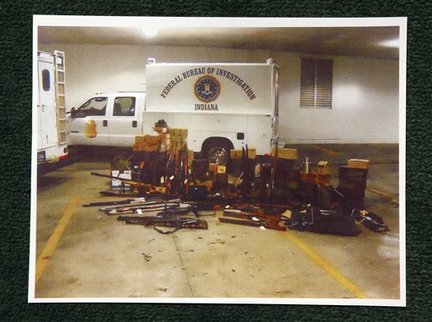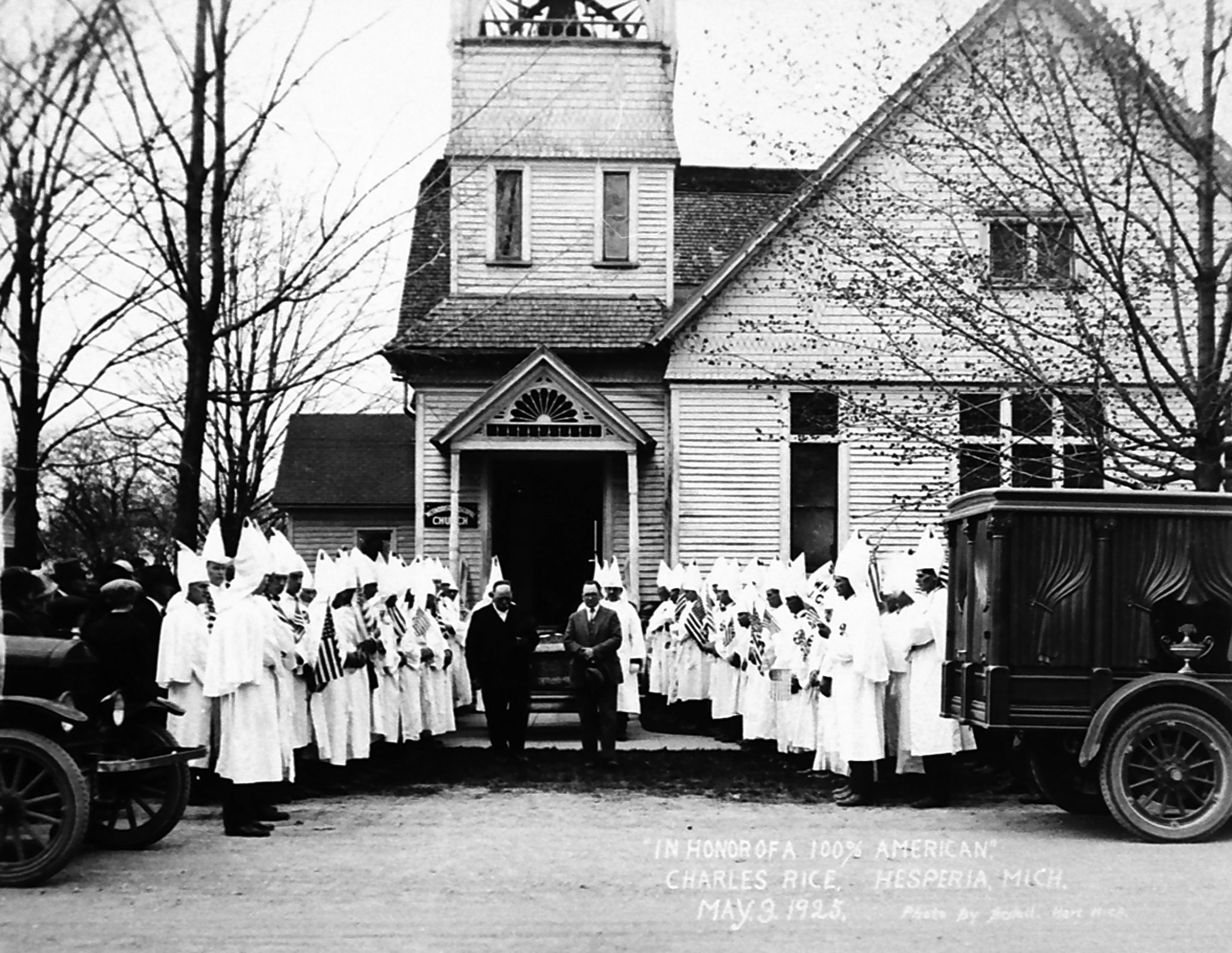Alex Constantine - July 20, 2012
File photo | MLive.com Klan members gathered in a field off Seymour Street. A parade that stretched two miles long left from there and wound its way throughout downtown.
By Leanne Smith | lsmith32@mlive.com
MLive, July 05, 2012
JACKSON, MI – It was a Fourth of July festival few at the time likely would ever forget.
Under a cloudless sky on a warm day in a field along Seymour Street, vendors sold food, drinks, confections, tobacco and souvenirs; a national leader spoke on important issues of the day; bands played and an aerial acrobat performed stunts on the wing of a plane before parachuting to the ground to the amazement of all.
Fireworks lit up the sky and a parade two miles long filed through downtown, and most of its participants wore distinctive costumes – flowing white robes and hoods with pointed tops.
Called the Klonvocation of the first Klonklave of the Knights of the Ku Klux Klan, the rally that brought 100,000 people to Jackson was one of the largest the KKK ever hosted in Michigan. And it was in Jackson on July 4, 1924.
On Labor Day the same year, an even bigger Ku Klux Klan rally filled downtown Lansing. A year later, on July 4, 1925, the Klan’s pick for its festivities was Grand Rapids.
It’s likely they’re all events people would rather forget or wish they didn’t know about. But Klan parades, picnics and mass celebrations then were typical family-friendly entertainment, according to British historian Craig Fox.
“Everyday Klansfolk: White Protestant Life and the KKK in 1920s Michigan,” a book written by Fox and published last year by Michigan State University Press, tells the story of the widespread popularity of the Klan in the North in the 1920s.
As Fox writes, the KKK in the ‘20s was not like the feared groups of the 1860s or even 1960s. It was, he said, sort of a fraternal lodge built on patriotism, Protestantism and morality mixed with anti-Catholic, anti-immigrant and bigoted views.
Wesley Dick, Albion College history professor agrees.
“The 1920s KKK was anti-Black, and profoundly anti-Semitic, anti-Catholic, anti-Communist, anti-liberated women and anti-alcohol,” he said. “The KKK was fraternal, serving to ease the transition from rural to urban America, as many in the cities, such as Jackson, had come from farms.”
Chapters were established in rural areas like Newaygo and Mecosta counties, as well as in cities, like Jackson, Lansing, Grand Rapids, Detroit, Flint, Saginaw, Bay City, Kalamazoo and Muskegon.
Any male, white, Protestant, native-born American of “good moral character” over the age of 18 was recruited to join at gatherings like the one in Jackson, which the Citizen Patriot reported signed up 600 new members, who recited the Klan’s oath before a huge flaming cross.
Jackson’s rally coincided with the Democratic National Convention in New York's Madison Square Garden, at which the KKK backed prominent but unsuccessful candidates for U.S. president.
Imperial Wizard Hiram Wesley Evans attended the Jackson rally, though, and the Citizen-Patriot reported his speech focused on home, church and the public schools. He was frequently interrupted by cheers and applause as he attacked parochial schools, saying “all children in all of America should stand side-by-side in the public schools,” the paper reported.
The biggest spectacle of the day, though, was the parade, attended by more than 7,000 Klansmen from 42 counties from throughout Michigan.
It walked down Seymour Street and along W. Michigan Avenue to the city's Civil War monument on Wildwood Avenue. Then, it continued up W. Michigan Avenue, turned right on N. West Avenue, right again on Ganson Street, and back to Seymour Street and the grounds.
Jackson had two known chapters of the KKK, which both had offices in a building at the corner of Mechanic and Pearl streets. But they were not represented in the parade except by members of the Junior Klan, for boys age 12 to 18.
Those in charge of the rally were well satisfied with the manner in which the large crowd conducted itself and order prevailed throughout the day and evening, the Citizen Patriot reported.
The paper extensively covered the rally in the next day’s paper. But Evans was the only person in attendance it ever mentioned in the paper by name.
Tidbits
• In 1920, the Ku Klux Klan had fewer than 5,000 members nationwide. By 1922, there were 100,000 members.
• Michigan’s top Klan leader in 1924, King Kleagle Paul A. Beckett, apparently lived in Jackson then. He's listed as an attorney in the 1924 city directory, but isn't found in any directories before or after.
• About 200 people were treated at Jackson hospitals after collapsing from heat exhaustion at the Jackson KKK rally on July 4, 1924.
• More than 200 babies were cared for in a “nursery” set up on the Jackson grounds that was staffed by 46 women. It also reunited 50 lost children with their parents throughout the event.
• Outsiders were prevented from entering the Jackson rally grounds by about 330 Klansmen.
• The KKK’s nationwide collapse was as swift as its rise. When sex, murder and financial scandals involving the Klan’s national leaders erupted in 1925, “respectable” members began deserting in droves.
• A 1930 Michigan lawsuit exposed greed within the state organization. Testimony indicated that Klan members had used a series of scams to line their own pockets. Money that was supposed to buy an airplane, build a temple, start a newspaper and aid political candidates disappeared.
http://www.mlive.com/news/jackson/index.ssf/2012/07/peek_through_time_ku_klux_klan.html


